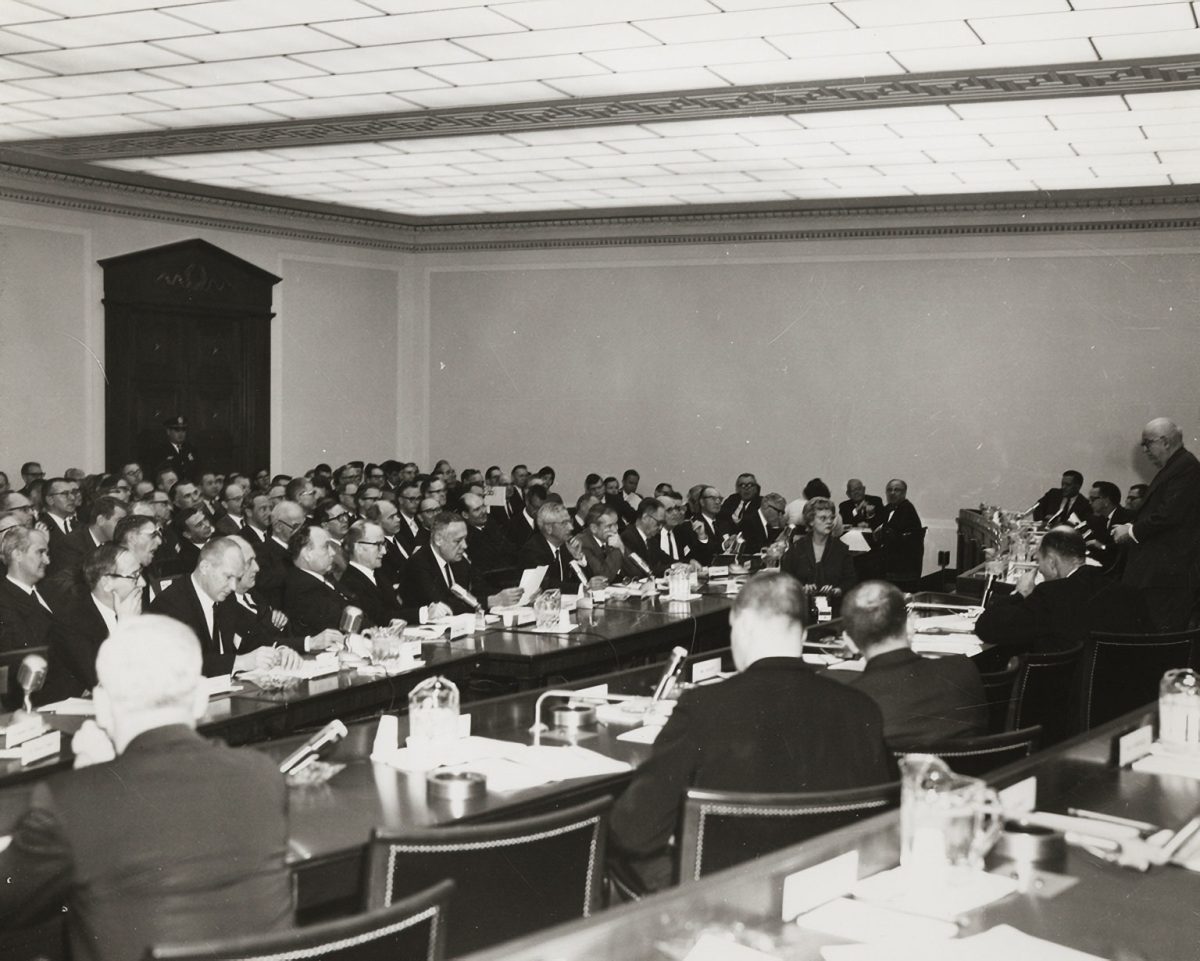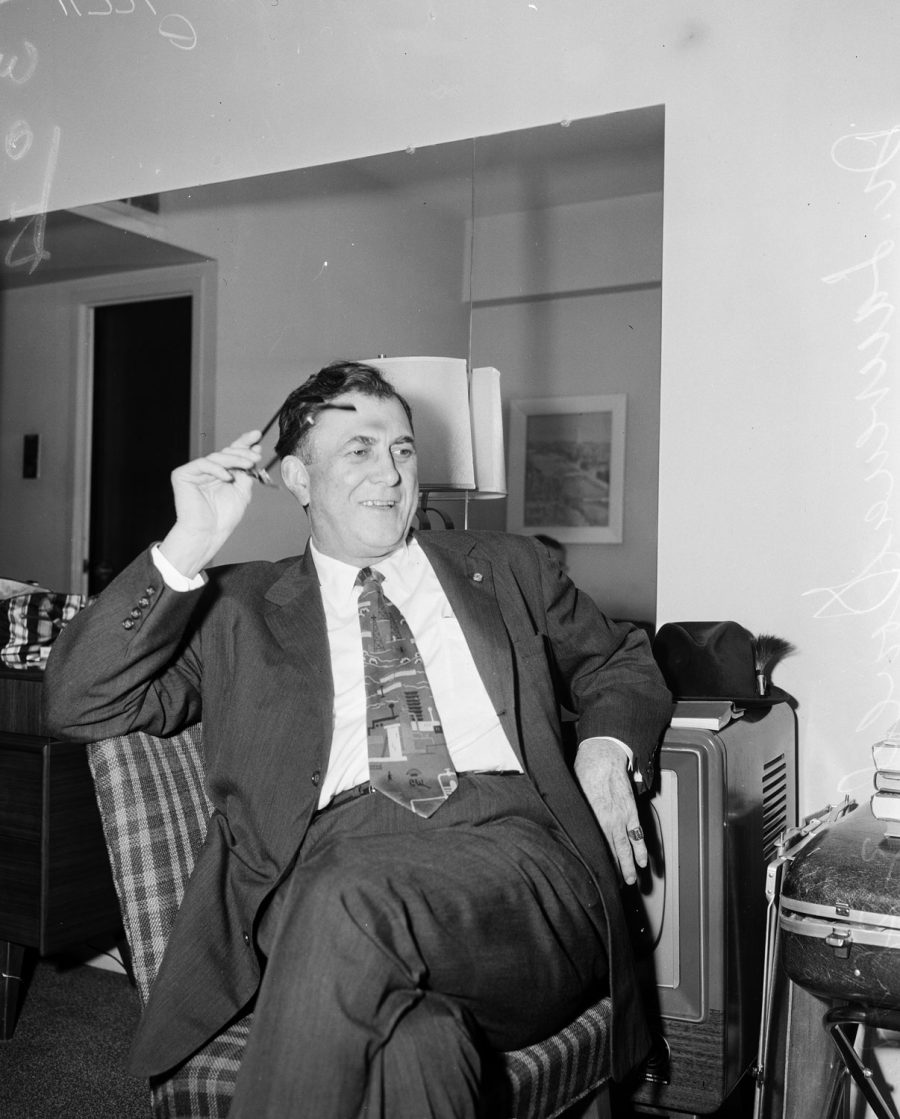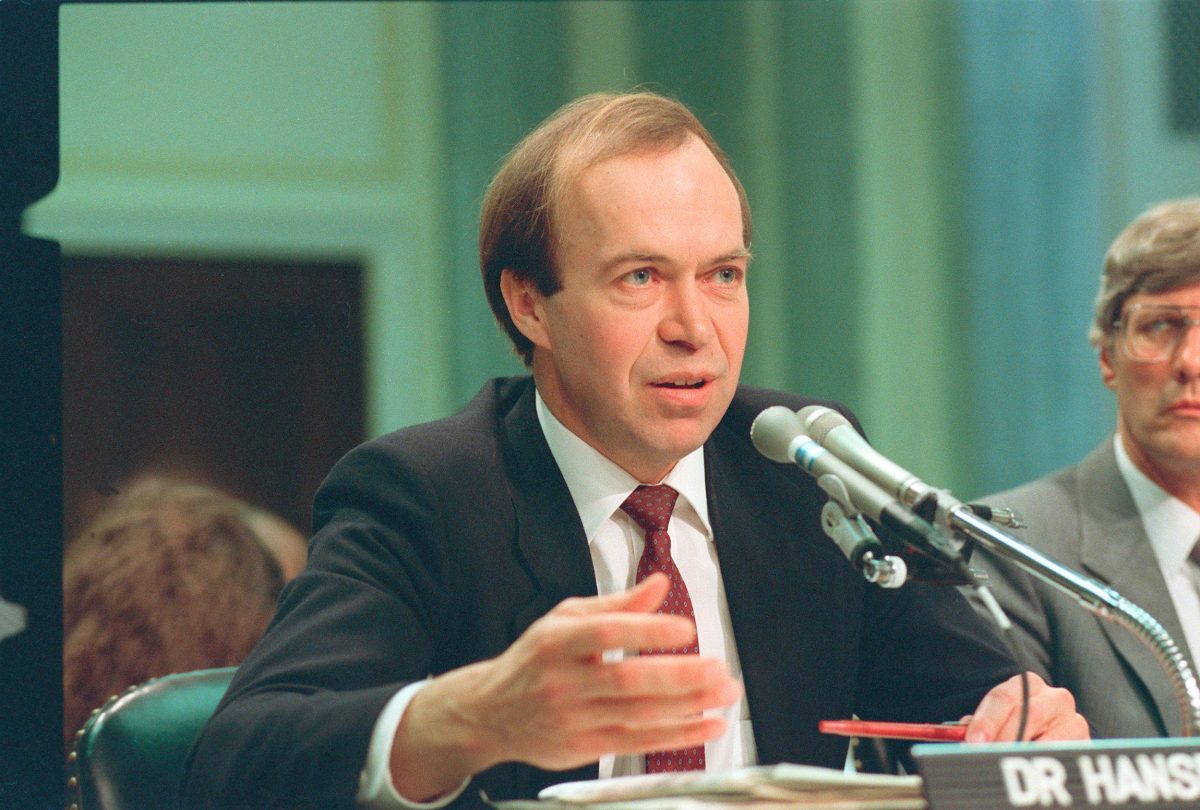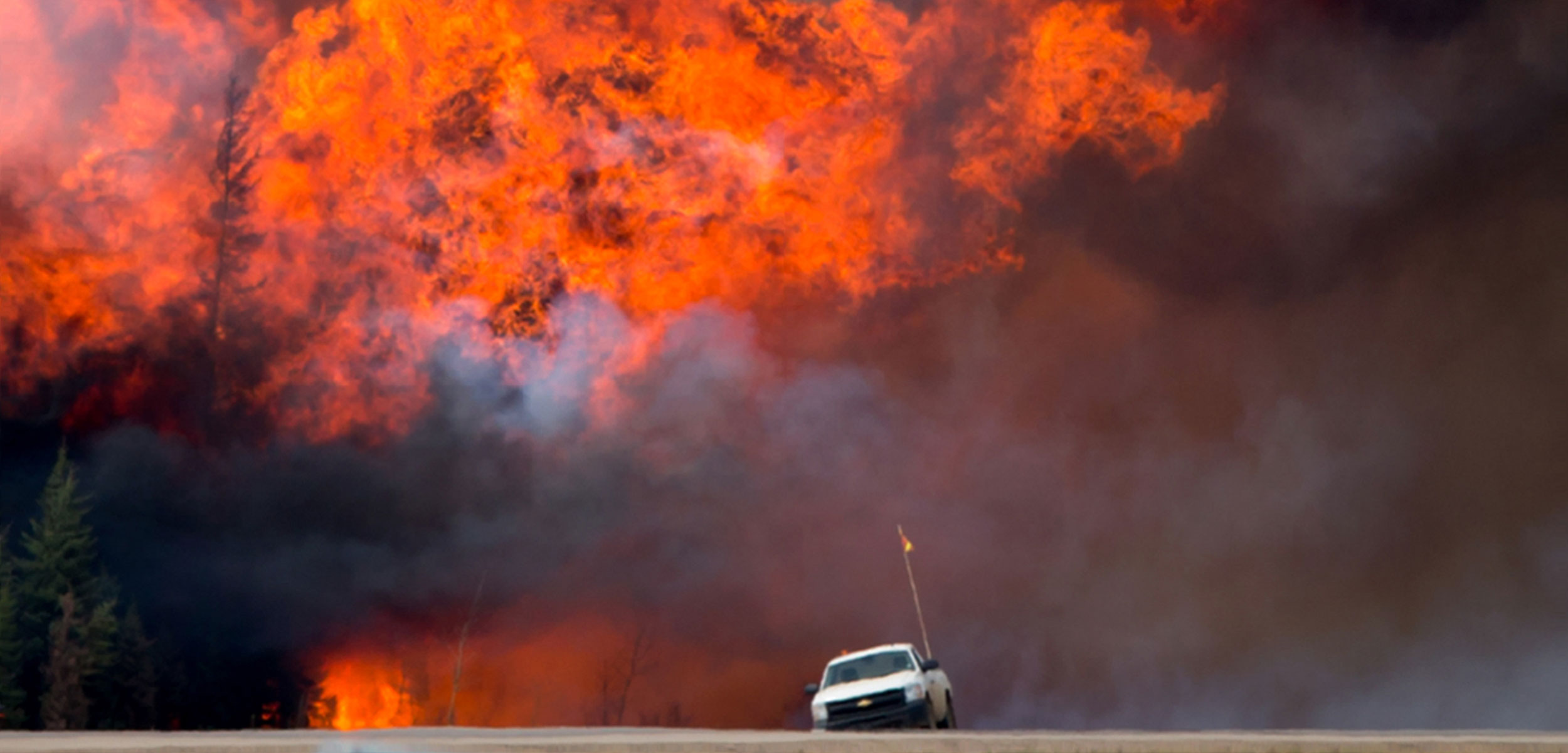The Decade of Sock Hops, Poodle Skirts, and Climate Change Awareness
In the 1950s, the science behind climate change was accepted and research was funded—but we lost sight of the future and set the world ablaze.
Article body copy
The following excerpt is from writer John Vaillant’s latest book, Fire Weather: A True Story from a Hotter World. Vaillant weaves together the story of the devastating 2016 Fort McMurray fire in Alberta—and the resulting loss and grief—with the history of resource extraction and climate science. The glaciers may be melting, and seas rising, but as Valliant points out, perhaps more horrifically, the world is catching fire more often and more intensely than ever before.
One of the first people to calculate the impact of industrial CO₂ in a systematic way was a Canadian-born and British-raised steam engineer and amateur meteorologist named Guy Callendar. By the 1930s, there was already anecdotal evidence that the climate was warming, but Callendar was the first to actually track and graph it. His inquiry arose from an old-fashioned impulse: curiosity. The son of a successful (and wealthy) physicist, Callendar was free to pursue science for its own sake. He had doubts about carbon dioxide’s influence on Earth’s climate, and he wished to test it. After analyzing 100 years of temperature records from 200 weather stations around the globe, he detected a trend: the mean global temperature had risen 0.5 °C between 1890 and 1935. The similarities to NASA’s current data are uncanny. Callendar’s results were published in 1938, just as the automobile was achieving true ubiquity on North American and European roads.
The significance of Guy Callendar’s proposition, all but ignored at the time, was enormous: he was saying, unequivocally, that humans, due specifically to their preoccupation with combustion, had become a force of Nature. Callendar, who died in 1964, would live to see his work accepted, if not universally. In his lifetime, the link between CO₂ and temperature would come to be known as the Callendar Effect.
Following Callendar’s groundbreaking study, other scientists homed in on the connection between CO₂ and temperature, and the impact of human activities on the climate.
Starting in the early 1950s, a Canadian-born geophysicist named Gilbert Plass used infrared spectroscopy studies to challenge and, ultimately, reconfirm discoveries made over the previous two centuries: long-wave radiation—aka infrared radiation, aka solar heat—is retained by water vapor, and also by industrial CO₂. Prominent newspapers and magazines took an interest in Plass’s work, and the Washington Post covered it on May 5, 1953, employing as they did so some now-familiar similes: “Releases of carbon dioxide from coals and oils … blanket the Earth’s surface ‘like glass in a greenhouse.’ ”
The New York Times followed with a similar story a couple of weeks later, using the same imagery, and so did Time magazine: “In the hungry fires of industry, modern man burns nearly two billion tons [1.8 billion tonnes] of coal and oil each year. Along with the smoke and soot of commerce, his furnaces belch some six billion tons [5.5 billion tonnes] of unseen carbon dioxide into the already tainted air … This spreading envelope of gas around the Earth serves as a great greenhouse.”
In June 1953, Life, one of the most popular weekly magazines of the day, ran a 20-page article entitled “The Canopy of Air,” which addressed the suspected link between warming temperatures, rapid glacial retreat, and industrial CO₂. Three years later, in 1956, Plass would discuss his findings in American Scientist: “It is not usually appreciated,” he wrote in the July issue, “that very small changes in the average temperature can have appreciable influence on the climate. For example, … a rise in the average temperature of perhaps only 4 °C would bring a tropical climate to most of the Earth’s surface.”
What is refreshing, but also unnerving, about scientists is the way they relay their findings—mundane or devastating—in the same measured tones. An increase in average temperature of 4 °C would end life as we know it. (Currently, we are at roughly 1 °C above average, and already there is abundant evidence of disruption.) In the 20 years since Guy Callendar published his CO₂ and temperature graphs, the picture had already changed noticeably. After citing Callendar, Plass wrote, “Today, man by his own activities is increasing the percentage of carbon dioxide in the atmosphere by 30 percent a century.” (This is now a gross underestimate.)
Even though we emit carbon dioxide constantly—from our fires and engines, and from our very mouths—it remains, for most, an abstraction. In recent years, its role has become an article of faith that one can choose, or refuse, to believe. But its impacts are less subjective: “In the last 50 years,” wrote Plass in 1956, “virtually all known glaciers in both hemispheres have been retreating.” He continued: “There can be no doubt that this will become an increasingly serious problem as the level of industrial activity increases” (italics mine).
In his article, which he titled “Carbon Dioxide and Climate,” Plass went on to explain how the full exploitation of known coal reserves would drive up CO₂ levels by a factor of 10, pushing the average global temperature into uncharted territory. More disturbing than Plass’s conclusions, or his confidence, is the fact that his article was published almost 70 years ago. In this landmark work, we see for the first time the suggestion, albeit oblique, that to maintain any semblance of atmospheric equilibrium, humanity would need to moderate its use of fossil fuels (i.e. “keep it in the ground”). Throughout the 1950s, Plass’s work continued to be written up in scholarly journals and in well-regarded popular magazines and newspapers. And yet, as graphic, reasoned, and alarming as his message was, these articles passed through the news cycle and into the library stacks, leaving behind the barest ripple.
But unlike Guy Callendar, Gilbert Plass wasn’t alone. In addition to researchers in Europe, several scientists at Scripps Institution of Oceanography in California were also doing cutting-edge research on atmospheric CO₂. One of them, Roger Revelle, an oceanographer, former navy man, and the director of Scripps, became the first person to formally raise the topic of anthropogenic climate change before members of the US Congress.
On March 8, 1956, Revelle was called before the House Committee on Appropriations to discuss research and funding for the upcoming International Geophysical Year (IGY). The IGY (1957–58) was as much a diplomatic effort as a scientific one; it signaled a partial easing of Cold War hostilities that saw the archenemies Soviet Russia and the United States working cooperatively with dozens of other countries on a multipronged effort to better understand Earth’s atmospheric, marine, and terrestrial systems. The IGY’s objectives were magnificently ambitious and included programs for studying everything from polar auroras to the deepest ocean trenches, from the jet stream to the Gulf Stream. The vast array of planned experiments would showcase the latest technology from satellites to bathyspheres, and samples would be taken from anything remotely measurable—from the most ancient glacial ice to the most ephemeral atmospheric gases. In many ways, the International Geophysical Year showed humanity at its best, and it was a great honor to be included in such a historic endeavor.

Oceanographer Roger Revelle testifying at the US House of Representatives on May 1, 1957. Back then, politicians did not view the threat of climate change through a purely political lens. They listened respectfully to scientists. Photo public domain
When Revelle addressed a subcommittee of the Appropriations Committee on that balmy March morning, their questions were focused on polar research. In the United States, in the 1950s, “polar research” included where to dump rapidly growing quantities of nuclear waste, and how the ice caps might be used to hide nuclear submarines and launch missile attacks. More relevant to Revelle’s expertise was how long those ice caps would even last.
“Human beings during the next few decades may, almost in spite of themselves, be doing something that will have a major effect on the climate of the Earth,” Revelle said to the committee. “I refer to the combustion of coal, oil, and natural gas by our worldwide civilization, which adds carbon dioxide to the atmosphere. In this way, we are returning to the air and the sea the carbon stored in sedimentary rocks over hundreds of millions of years. From the standpoint of meteorologists and oceanographers, we are carrying out a tremendous geophysical experiment of a kind that could not have happened in the past or be reproduced in the future. If all this carbon dioxide stays in the atmosphere, it will certainly affect the climate of the Earth, and this may be a very large effect. The slight general warming that has occurred in northern latitudes during recent decades may be greatly intensified.”
Representative Albert Thomas, a right-leaning Texas Democrat, weighed in: “Didn’t I read, from what Dr. Gould says, we have been warming up for the last 50 years?”
Dr. Laurence Gould was chairman of the US National Committee’s Antarctic Committee, and one can see why his introductory remarks would have caught the Texas lawmaker’s attention: “Glacier studies,” Gould wrote,
have given clear indications that we are now in a cycle of warming which began about 1900. It is estimated that if the indicated warming continues for another 25 to 50 years (c. 2000), the ice will melt out of the Arctic Ocean in the summer making it navigable. In addition, the warming cycle, if continued, may melt enough ice tied up in glaciers to add to the sea level sufficiently to affect the lives of millions of people living along low coastal lands. It is conceivable within 20 or 25 years (c. 1980) a peninsula such as Florida might become inundated. Whether this actually happens or not, the slow change of climate has already begun to show a change of storm paths and redistribution of rainfall.

In the 1950s, geologist Laurence Gould warned policymakers about a warming world, glacial melt, and sea level rise. Photo by Los Angeles Examiner/USC Libraries/Corbis/Getty Images
“The reason [for this new warming cycle],” Revelle explained, “may be because we have been adding carbon dioxide to the atmosphere … One of the aspects of this IGY oceanographic program is to try to find out what proportion of the total carbon dioxide produced by the burning of fossil fuels goes into the ocean and how much stays in the atmosphere.”
“This gas that you speak of, has that had any effect on human life, do you know?” asked New York Democratic representative Harold Ostertag.
“It may be having an effect already,” Revelle answered, “primarily through the effect on the weather … The increase in the number of hurricanes on the east coast, however, is certainly tied in one way or the other with the general northward movement of the warm air.” It bears noting that these observations and exchanges were entered into the Congressional Record in 1956, 15 years before the first Earth Day, and 35 years before the International Panel on Climate Change released its first report. There was no such thing as “climate denial” then, and there were no “climate skeptics.” Those present, all of whom were white men, and most of whom were churchgoers born at the very dawn of the automotive age, were open-minded about this alarming new information, and they discussed it with intelligent interest.
In May of the following year, Revelle was summoned to Washington, DC, again for a progress report on America’s participation in the International Geophysical Year. He opened the afternoon session with extensive remarks on what he referred to as “heat balance,” and he began in a way that seems surprisingly holistic for a Cold War–era scientist and former military man. The fact that he was also a sailor from Southern California might have had something to do with it. “I think the best way to introduce this subject,” he began, “is to point out to you gentlemen something which is not often thought of, and that is that the Earth itself is a spaceship … We have lived here on this spaceship of our Earth for a good many hundred thousand years, and we human beings are specifically adapted to it . . . Our whole physiology and psychology really depend upon the characteristics of the Earth.”
Albert Thomas, the congressman from Texas, wasn’t impressed. “You are talking like an environmentalist,” he said. “I thought that you believed in heredity.”*
Revelle, whose affinity for his subject was as soulful as it was scholarly, continued undeterred. “We are certainly shaped by the Earth on which we live,” he said. “A simple example is that we breathe oxygen. This is the only planet in the solar system we know of that has free oxygen on it—”
“That will not be free long,” growled the congressman. “The federal government will tax it.”
Revelle persevered: “—and this is the only planet that has large bodies of liquid water on it. The fact that water has such a great capacity for storing heat means that it can absorb a great deal of radiation and not change its temperature very much.”
Thomas, a veteran of the First World War and a forceful politician credited with bringing the Johnson Space Center to his home district of Houston, may have presented like a crusty Texas oilman, but he was listening. “You have announced,” he said, “a very fundamental principle of weather when you said that these vast bodies of water are reservoirs for tremendous heat loads.”
“That is correct, sir,” said Revelle.
After a lengthy exchange about drought and water shortages, particularly in Thomas’s and Revelle’s home states, Revelle moved on to short- and long-term weather forecasting. “You used the word ‘climate’ there for the long range,” Thomas said, “and ‘weather’ for the day-to-day basis?”
“That’s right,” said Revelle.
Eisenhower was president, nuclear Armageddon was a preoccupying concern, and Thomas would soon be voting against the Civil Rights Act of 1957 (it passed anyway), but on this exceptionally warm May Day afternoon a conservative Texan was talking climate science with a West Coast progressive on Capitol Hill. Revelle went on to say that if industrial CO₂ increased by 20 percent, as predicted, “It would mean that … Southern California and a good part of Texas, instead of being just barely livable as they are now, would become real deserts.”
There followed some back and forth about the causes and impacts of drought in ancient Greece and Mesopotamia, and then this remarkably prescient conversation continued.
“From a weather point of view,” Thomas asked, “how did that happen?”
“No one knows,” Revelle said.
“There is no theory behind it or anything?”
“This carbon dioxide thing that I was talking about,” said Revelle, “is in fact a way to test some of these theories.”
Thomas tried to grasp it: “Carbon dioxide absorbs the infrared rays that are bouncing back from the Earth, and when they are absorbed, that absorbs the heat and therefore, what?”
“It raises the temperature,” Revelle said. “It is like a greenhouse … If you increase the temperature of the Earth, the north latitude belt, which covers most of the western part of the United States and the Southwest, would move to the north. Does this make any sense?”
“Yes,” said Thomas. Then, the discussion turned to ocean currents.
Revelle’s warnings to those long-dead congressmen have turned out to be surgically accurate. The 20 percent increase in industrial CO₂ that Revelle predicted in 1957 was achieved in 2004, along with the anticipated atmospheric changes. The kind of disruption Revelle alluded to in the context of drought and rainfall is now referred to as a “phase shift”: a dramatic, effectively irreversible change in a region’s climate regime. There is abundant evidence that phase shifts are now underway across much of the planet. Fire behavior is just one indicator, but it is a graphic one, and Revelle’s home state of California offers a good example: in the 1950s, the state’s fire season lasted about four months; today, it is effectively year round, and the acreage burned during the most severe seasons (1950 versus 2020) has increased eightfold (to say nothing of lives and property lost).† Meanwhile, the drought Revelle predicted has become a serious and persistent condition—winter and summer, threatening the viability of mountain forests, agricultural lands, and the waterways that link them. As for fire tornadoes, those exceeded even Revelle’s powers of prediction.
These historic exchanges between men of such different backgrounds and philosophies were a wonderful byproduct of the International Geophysical Year (as well as a reminder of how the US Congress is capable of functioning). While the crucial link between fossil fuel burning and carbon dioxide garnered neither the attention nor the action it deserved, Roger Revelle and his colleagues did secure funding to study it. Given where things stand today, it is sobering to consider that Revelle addressed these matters, accurately and emphatically, more than 30 years before the NASA scientist James Hansen gave his own historic testimony before Congress. Since Revelle’s presentations on Capitol Hill, three generations, amounting to five billion people, have been added to the world’s population, along with billions of fuel-burning vehicles, engines, stoves, generators, and power plants of all sizes. In that time, annual CO₂ emissions have increased fivefold from their already climate-altering 1950s levels.

James Hansen, a NASA scientist, testified about the dangers of climate change before the US Senate in 1989. When Hansen kept speaking out, White House–appointed NASA administrators silenced him. Photo by Dennis Cook/AP Images
It may not have kept pace with car sales, emissions, or population, but climate science continued to gain traction in the scientific community. Like germ theory and continental drift before it, the greenhouse effect, once a provocative idea swirling in the back eddies of scientific inquiry, was drawn into the mainstream, thanks in large part to Gilbert Plass and Roger Revelle. Fragmented though their efforts were, a picture was taking shape across the scientific community. There is a doomed, Cassandra-like quality to these early climate messengers. They had the vision to see what was coming, and the science to support it, but their words, however eloquent, or urgent, seemed unable to penetrate the collective consciousness—to be truly heard. Part of the problem was the nature of their message: not only was it abstract in the extreme, it ran absolutely counter to the bullish and triumphal postwar narrative: it was patriotic and unifying to challenge communists and dictators, but not the billowing chimneys of industry or the exhaust pipe of the family car.
As new and challenging as these ideas were, sincere attempts were made to introduce them to the mainstream. It may come as a surprise today, but in 1958, the potential for CO₂-driven climate disruption was part of the public school curriculum. In the late 1950s and early 1960s, the director Frank Capra (It’s a Wonderful Life, etc.) collaborated with Bell Telephone (AT&T) on a series of educational films that were aired on national television and distributed widely through American schools. Using a hybrid of animation and live action popular at the time, 1958’s The Unchained Goddess featured Meteora, an animated Rita Hayworth–like weather deity who becomes infatuated with the domed and bespectacled Dr. Frank Baxter, a legendary (real-life) professor at the University of Southern California. Over the course of the film, Baxter, a truly delightful man, explains the science and mechanics of weather, finishing up with a warning that “man may be unwittingly changing the world’s climate through the waste products of his civilization … ” As Baxter paraphrases Gilbert Plass’s research and Roger Revelle’s lyricism, we see dramatic footage of collapsing glaciers juxtaposed with fuming smokestacks, bumper-to-bumper traffic, and animations of rising seas inundating the coastal United States. The Unchained Goddess, financed and distributed by one of the biggest and most powerful corporations in US history, was seen by tens of millions of young baby boomers.
* I believe Thomas meant “heredity” in the biblical sense: “the law by which living beings tend to repeat their characteristics, physiological and psychical, in their offspring” (International Standard Bible Encyclopedia).
† In New Mexico, fire weather days have increased by 120 percent since 1973.
 Excerpted from Fire Weather by John Vaillant. Copyright © 2023 John Vaillant. Published by Alfred A. Knopf Canada, a division of Penguin Random House Canada Limited. Reproduced by arrangement with the Publisher. All rights reserved.
Excerpted from Fire Weather by John Vaillant. Copyright © 2023 John Vaillant. Published by Alfred A. Knopf Canada, a division of Penguin Random House Canada Limited. Reproduced by arrangement with the Publisher. All rights reserved.

